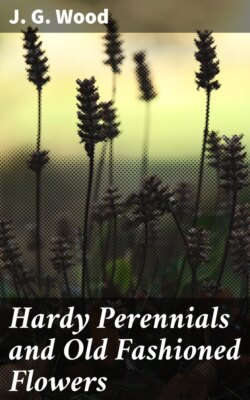Читать книгу Hardy Perennials and Old Fashioned Flowers - J. G. Wood - Страница 53
На сайте Литреса книга снята с продажи.
Campanula Waldsteiniana.
ОглавлениеTable of Contents
Nat. Ord. Campanulaceæ.
A rare and distinct alpine species from Carinthia. It proves perfectly hardy in this climate. For the rock garden it is a gem of the first water, its habit being dwarf, dense, and rigid; floriferous as many of the Bellflowers are, I know none to excel this one. As may be observed in the following description, there are not a few distinctive traits about it, which, more or less, go to make it a desirable subject for rare and choice collections.
The flowers are a glistening bluish-lilac, erect, and ¾in. across when fully expanded. The corolla can hardly be said to be bell-shaped, as the five divisions are two-thirds of its depth, which allows it, when full blown, to become nearly flat, and as the segments are equal, sharply cut, and pointed, the flower has a star-like appearance. The little calyx is cup-shaped, angular, and has small, stout, horn-like segments, which are bent downwards. Each flower has a pedicel about 1in. long, which springs from the axils of the main stem leaves; the stems seldom exceed the height of 4in. or 5in., and they are exceedingly fine, thready, as also are the pedicels; they are, moreover, of zigzag form, from node to node. The leaves are ¾in. long, and less than ½in. wide, ovate or nearly cordate, partially folded, and sometimes reflexed at the ends, nearly stalkless, slightly toothed, smooth, of good substance and a peculiar grey-green colour. The foliage for two or three weeks is completely hidden by the large number of flowers, during which time it is a most attractive subject.
I grow it with other dwarf Campanulas in a collection bed, where it compares well with the finest, such as C. pulla, C. muralis, and C. Zoysii, for effectiveness. Having proved it to thrive well in light sandy soil of a vegetable character, I have not tried it otherwise; it enjoys a sunny situation. The site should be well drained; it will endure nothing like stagnant moisture—its peculiar roots would indicate this fact, they are not only tender and fleshy, but thick and of a pith-like nature, and, as I have never been able to gather any seed, and the propagation has to be carried out by root division, there requires to be a careful manipulation of these parts, for not only do they split and break with the least strain, but when so mutilated they are very liable to rot. I have found it by far the better plan to divide this plant after it has begun to grow in March or April, when its fine shining black shoots, which resemble horse hairs in appearance, are about ½in. high. Slugs are fond of this plant; a dressing once a week of sand and soot, when it begins to grow, will keep them off.
Flowering period, July and August.
